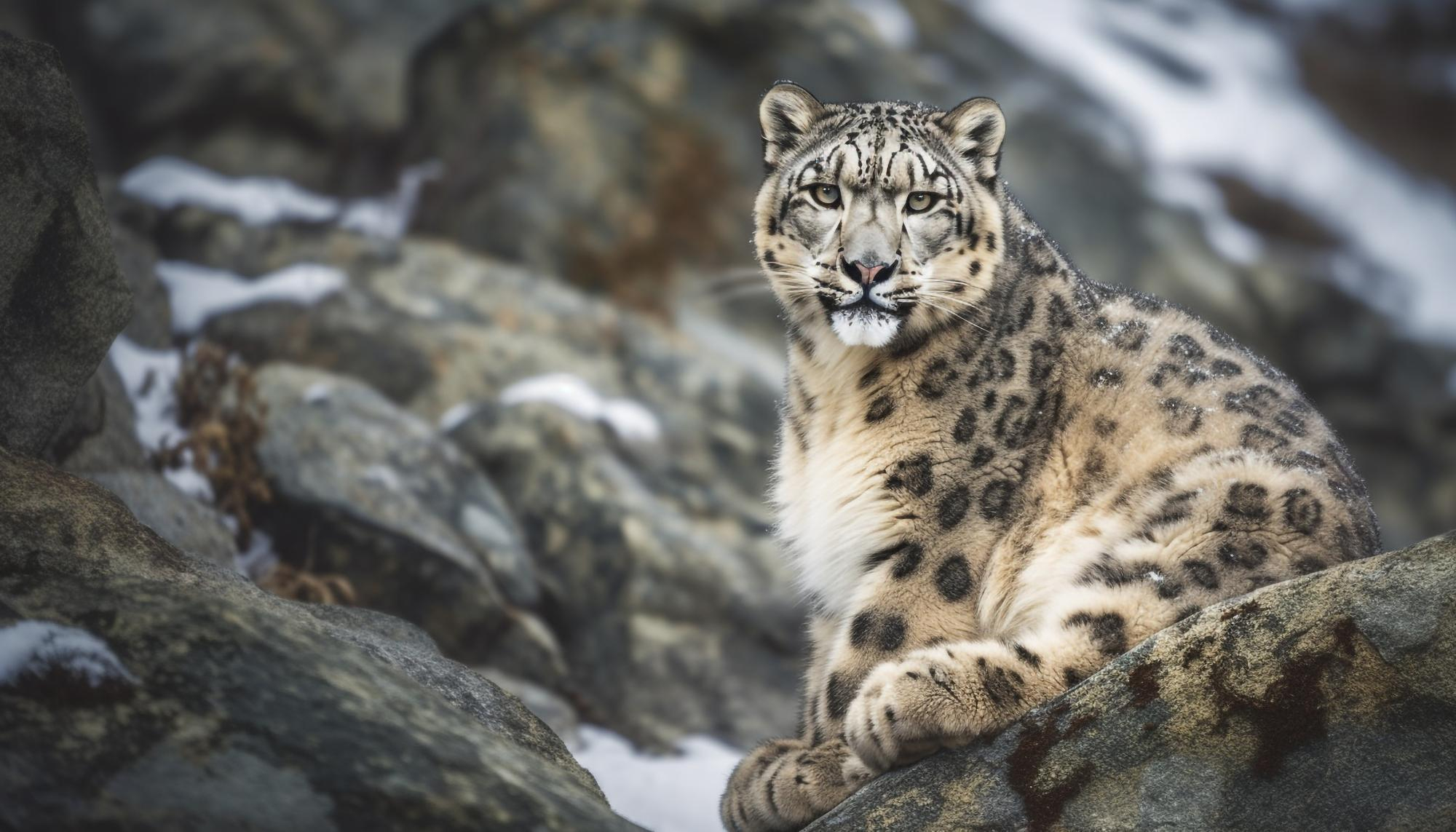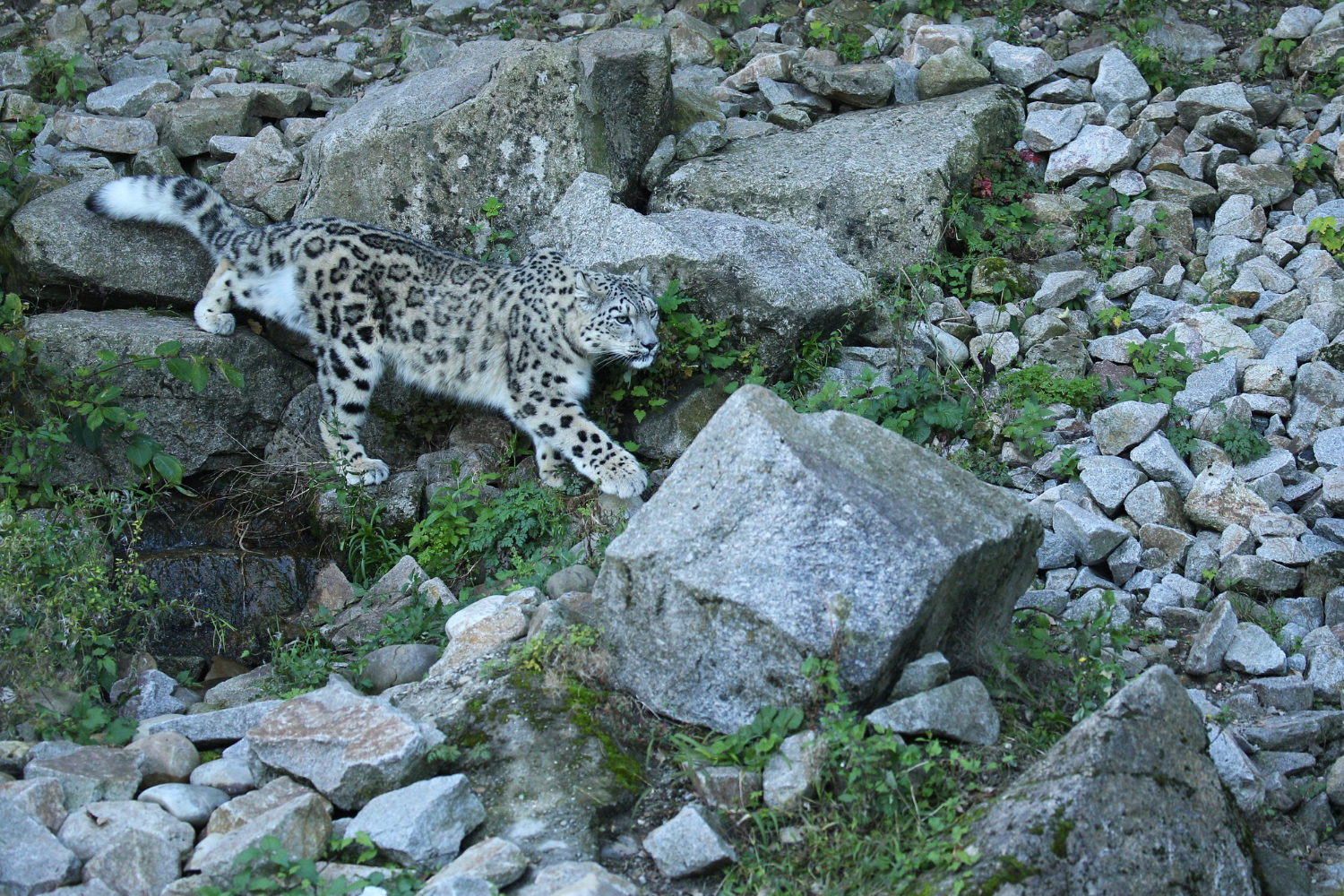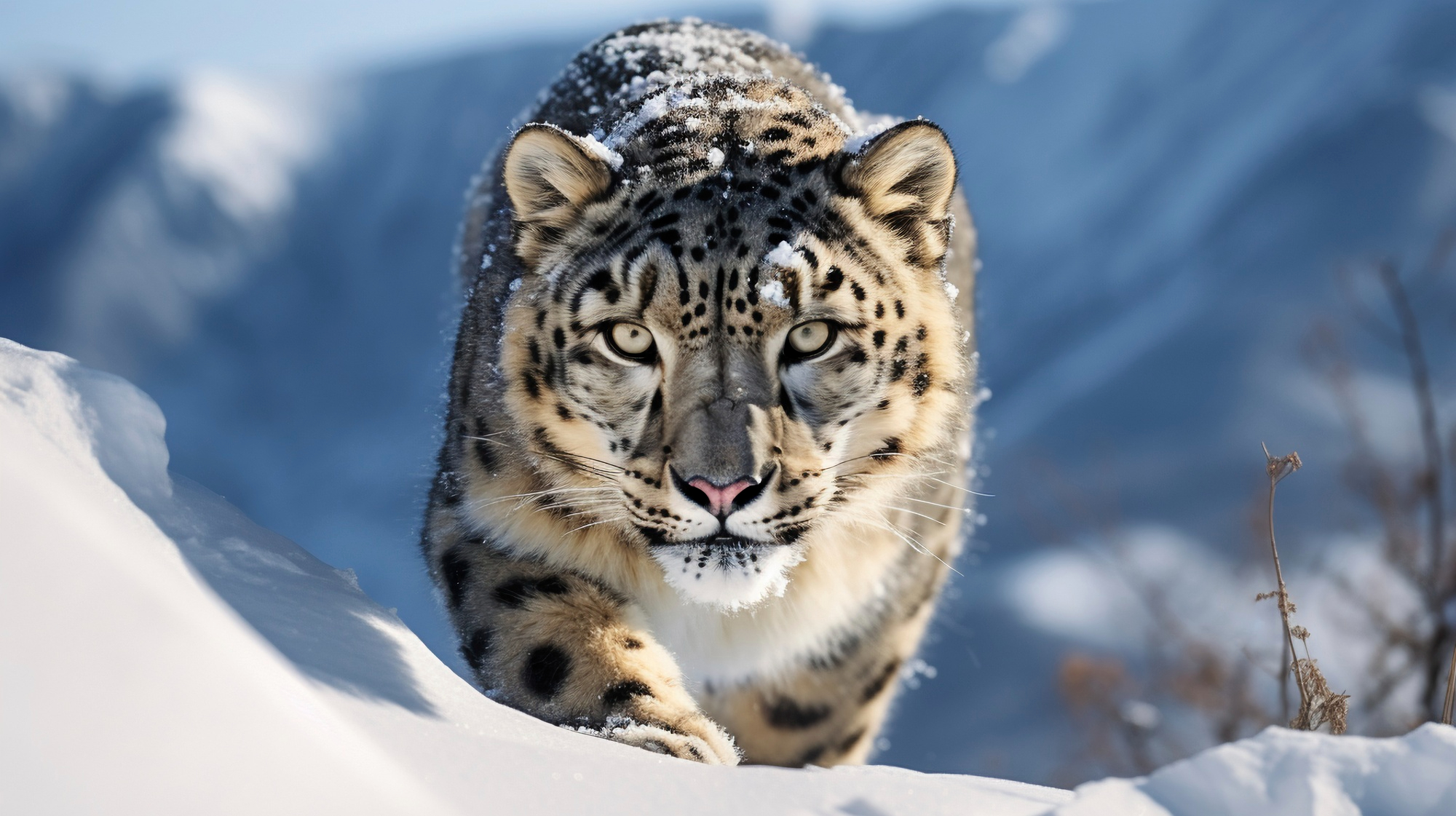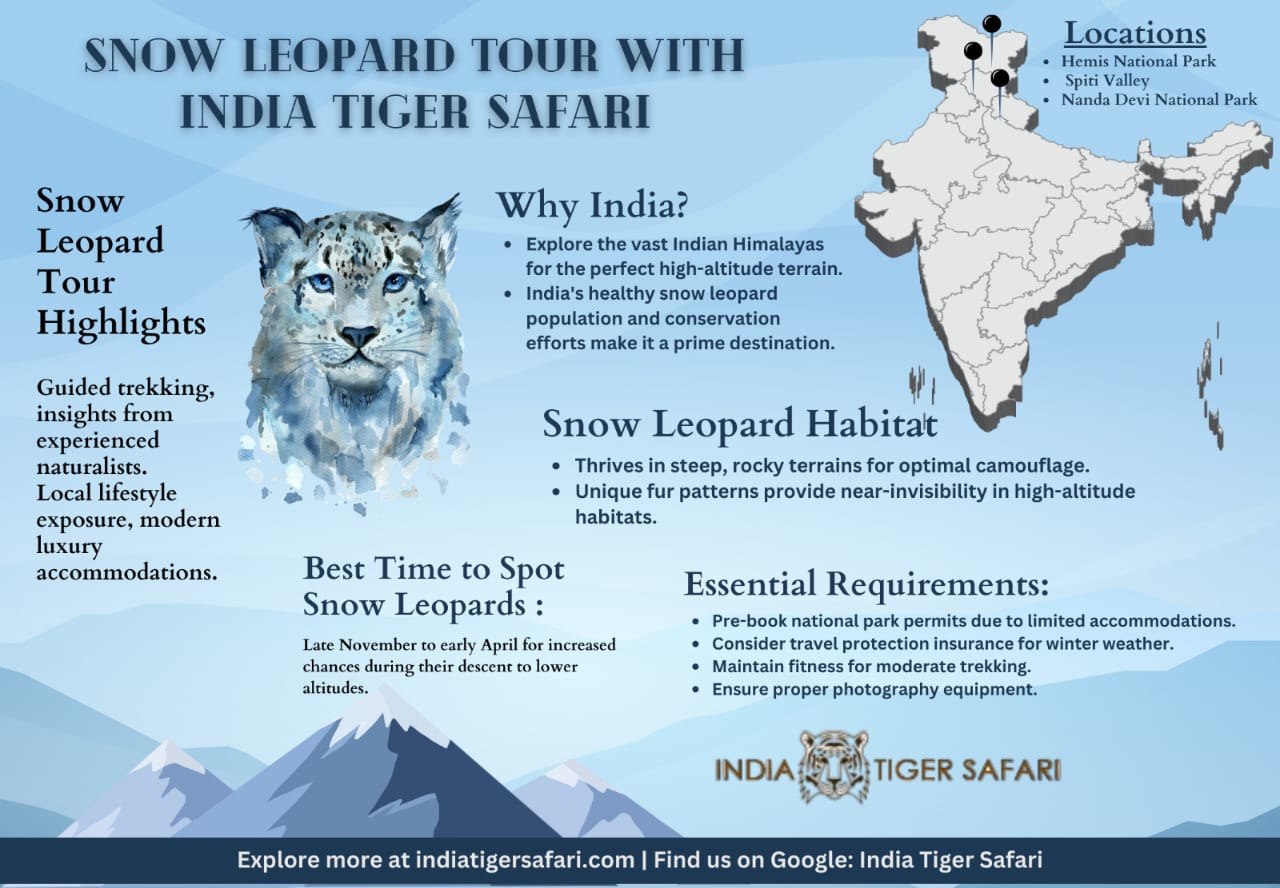
India Tiger Safari experiences, much like the encounters with the elusive snow leopards in the high mountains, have captivated wildlife enthusiasts and travelers from around the globe. Just as the snow leopard is hailed as the ‘Ghost of the Mountains,’ spotting a tiger in the wild expanses of India’s reserves is a dream many cherish. If India is on your bucket list for a snow leopard tour, here’s a detailed guide on when and where to go:
Why India?
The Indian Himalayas, spanning the states of Jammu and Kashmir, Himachal Pradesh, Uttarakhand, and Sikkim, provide a vast expanse of high-altitude terrain, perfect for snow leopards. The healthy population of these cats and numerous protected areas dedicated to their conservation make India one of the top destinations for snow leopard sightings.
Snow leopards are fascinating creatures that have adapted to thrive in some of the most challenging environments on Earth. They are known for their preference for steep and rugged terrains with rocky outcrops and ravines. These elusive big cats are usually found at high elevations of 3,000-5,000 meters or even higher in the majestic Himalayan Mountains.
The choice of such a habitat is not a coincidence. The steep and rugged terrain provides snow leopards excellent cover to camouflage themselves from potential threats and predators. Their spotted fur pattern blends seamlessly with the rocky surroundings, making them almost invisible to unsuspecting prey.
Moreover, these elevated habitats offer snow leopards a clear view of their surroundings. From vantage points on cliffs or high ridges, they can survey vast areas and spot potential prey from afar. This gives them a strategic advantage when it comes to hunting as they can silently sneak up on their unsuspecting victims.
When can we see snow leopards in India?
- Winter (Late November to Early April): This is the prime time for snow leopard spotting. As winter sets in and the high-altitude regions receive heavy snowfall, snow leopards descend to lower altitudes for food, making them easier to spot. The temperatures can be freezing, dropping to -25°C sometimes, so be prepared with warm clothing and equipment.
- Early Spring (March to April): While the chances of spotting a snow leopard might be slightly lower than in peak winter, the warmer temperatures and clearer skies can offer a more comfortable experience.
Some of the birds that you may come across while on the Snow Leopard tour are Golden Eagle, Lammergeyer, Eurasian Eagle Owl, Himalayan Griffon and Himalayan Snow cock, Tibetan Partridge, Chukar Partridge, White Winged Redstart, White Browed Tit Warbler, Robin Accentor, White Throated Dipper, Brown Dipper.
Some other wildlife that you may see is the Asiatic Ibex, Blue Sheep, Ladakh Urial, Red Fox and the Tibetan Wolf.
Where is snow leopard found in Indian states?
Although Snow Leopard is all along the Himalayan Range below are some of best places to see them.
1. Hemis National Park, Ladakh:
- Best Time: Late January to mid-March.
- Highlights: One of the best places in the world to spot snow leopards in the wild. The Rumbak Valley within the park is particularly famous. You can see other wildlife besides the snow leopard, like the Eurasian brown bear, Tibetan wolf, and the Himalayan blue sheep.
2. Spiti Valley, Himachal Pradesh:
- Best Time: February to March.
- Highlights: Spiti Valley offers some of the most breathtaking landscapes in India. The villages of Kibber and Langza are known hotspots for snow leopard sightings.
3. Nanda Devi National Park and Valley of Flowers, Uttarakhand:
- Best Time: Late winter.
- Highlights: The region is a UNESCO World Heritage site with diverse flora and fauna. The chances of seeing a snow leopard here are lesser than in Ladakh or Spiti, but the scenic beauty is unmatched.
Snow Leopard Tour with India Tiger Safari
Tour Highlights:
- Trekking in the mountains in Ulley.
- Guided by experienced naturalists and Snow Leopard experts who have previously conducted BBC Planet Earth II / Silent Roar PBS / Steve Winter Photography.
- Opportunity to stay in Homestays and get a local lifestyle experience of Ladakh.
- Modern luxury accommodation in Leh and Heated rooms in Ulley.
- Insight into local Snow Leopard conservation and village homestay initiatives
Essential Requirements to Pre-Book National Park Permits
- Book Early – There is limited Lodge / Camp Accommodation in the region where you get to see Snow Leopard. Booking is made on first cum, first-serve basis with a deposit. Good Lodges and Naturalists in season are booked nearly a year in advance.
- We recommend travel protection insurance/ Trip cancellation insurance. Between missed connections, lost or delayed luggage, or medical emergencies, you want peace of mind that your travel investment is well protected. Please consider purchasing a travel protection plan before you pay a deposit for a Snow Leopard Tour in India.
- Travel when it snows as tracking is easy – December to Early April – Usually sunny days, but with dry chilly winds, the temperature can drop to minus Centigrade at night. Still, it will warm up as the sun comes out during the day—December’s maximum temperature averages 7°C, which can fall to -15°C. January and February can drop to -30°C to -35°C at night.
- Fitness – The Snow Leopard tour is moderately difficult as it requires walking/ Hiking which requires a certain level of fitness and endurance. it is recommended to practice jogging or running four to five days a week and see if you can cover 5 km in 30-40 minutes. In addition to this, you can also add some resistance workouts for legs (like squats and lunges), and core workouts into your training schedule.
Tips for a Successful Snow Leopard Tour:
Great Optics: Crucial for a Great Snow Leopard Trip – A snow leopard excursion to the Himalayas needs powerful optics. Most snow leopard sightings need some form of optics to enjoy viewing them. Close sightings do happen, but “close” is relative when it comes to snow leopards. 600 meters can be considered a close sighting. There are several sightings over a kilometer away on every trip. These are enjoyable. Great optics, mounted on a good tripod, is the difference between a highly enjoyable trip and a waste of money. We operate only small groups and try to maintain a minimum ratio of 1 scope to 2 guests.
Time for Acclimatization – Keep a minimum of 2 days for acclimatization before going to higher altitude.
Photography Equipment – You need 600-800mm focal lengths for shooting snow leopards typically. In case you don’t have that reach you can rent out the lenses for this expedition. A tripod is a must. Shorter focal lengths and wide angles should be kept handy as well.
- Hire a Local Guide: Local guides are invaluable. They are often the best spotters, familiar with the terrain and animal movement patterns. They may not speak good English or engage in long conversations, but their experience and skill in spotting Leopards makes it worthwhile to have them accompany you.
- Patience is Key: Snow leopards are elusive. Sometimes, it takes days to spot one, so patience and persistence are crucial.
- Pack Right: Ensure you have suitable clothing, camera equipment, and camping gear for a multi-day trek.
- Respect the Environment: Always remember you are in the snow leopard’s home. Maintain silence, avoid littering, and minimize your impact on the fragile ecosystem.
- Stay Updated: Check local regulations, necessary permits, and weather updates before your trip.
Responsible Tourism:
It’s important to prioritize responsible tourism practices during your snow leopard tour. Respect the natural habitat of these animals, follow guidelines provided by your guides, and maintain a safe distance to avoid disturbing their behaviour.
In conclusion, planning a snow leopard tour in India is an adventure of a lifetime. The thrill of spotting one of these magnificent creatures in the wild against the backdrop of the stunning Himalayas is an experience that will remain etched in your memory forever. With the proper planning and respect for nature, this trip can be both exhilarating and fulfilling. Safe travels!


